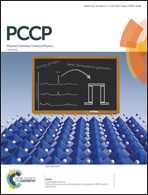A journey from calix[4]arene to calix[6] and calix[8]arene reveals more than a matter of size. Receptor concentration affects the stability and stoichiometric nature of the complexes†
Abstract
The formation of inclusion complexes between lucigenin (N,N′-dimethyl-9,9′-biacridinium dinitrate) and p-sulfonatocalix[n]arenes (SCn; n = 6, 8) was investigated by fluorescence and NMR spectroscopy. Both SC6 and SC8 were found to form 1 : 1 and 1 : 2 host–guest complexes with lucigenin showing up to 109 M−1 binding affinities. Strong quenching of the lucigenin fluorescence upon complexation was observed. Fluorescence regeneration after competitive binding with other potential guests present in solution was used as an indicator displacement assay to characterize the binding mechanism and affinity of alkaline metal ions (Li+, Na+, K+ and Cs+) with SC6 and SC8. The results demonstrate the formation of 1 : 1 and 1 : 2 calixarene : metal complexes with association constants on the order of 103 M−1 and heteroternary calixarene : lucigenin : metal complexes that predominate at metal cation concentrations above the millimolar range. Owing to the ubiquitous presence of metal cations in SCn solutions as counterions (typically Na+), the detailed description of the complexation of these species is crucial to understand and quantify the host–guest binding properties of these receptors. This work demonstrates that both the thermodynamic stability and the stoichiometric nature of the complexes is dependent on the metal ion concentration and, consequently, on the calixarene concentration.
![Graphical abstract: A journey from calix[4]arene to calix[6] and calix[8]arene reveals more than a matter of size. Receptor concentration affects the stability and stoichiometric nature of the complexes](/en/Image/Get?imageInfo.ImageType=GA&imageInfo.ImageIdentifier.ManuscriptID=C7CP01889D&imageInfo.ImageIdentifier.Year=2017)
- This article is part of the themed collection: 2017 PCCP HOT Articles


 Please wait while we load your content...
Please wait while we load your content...